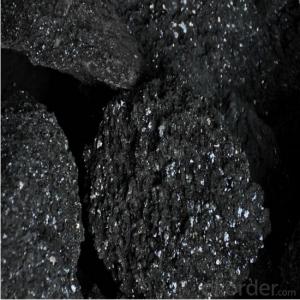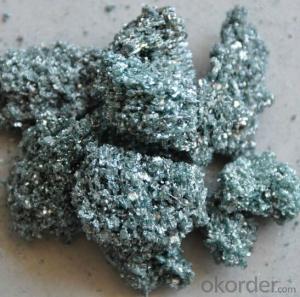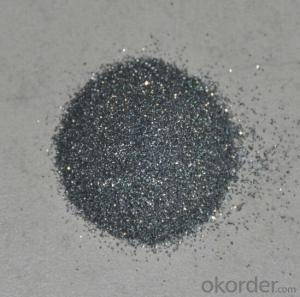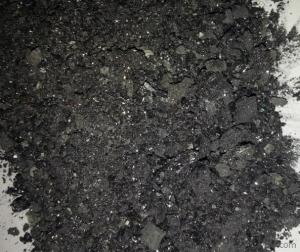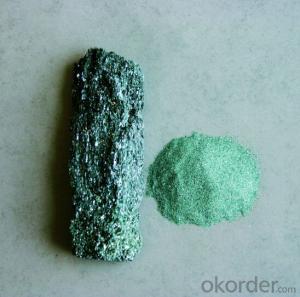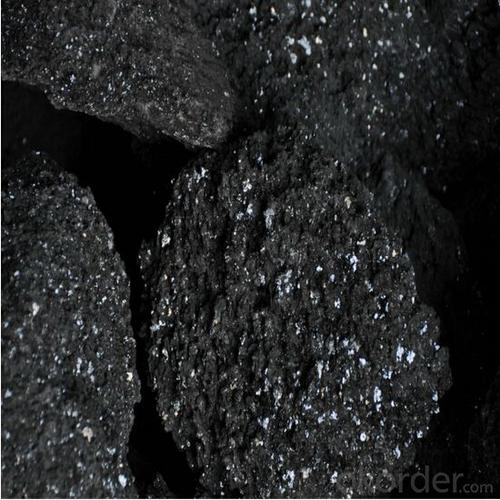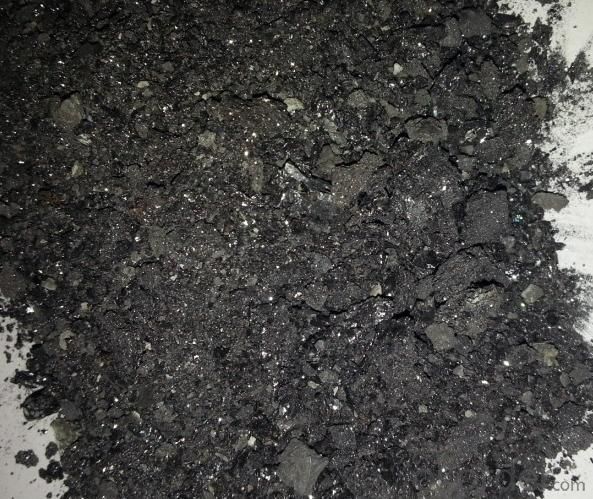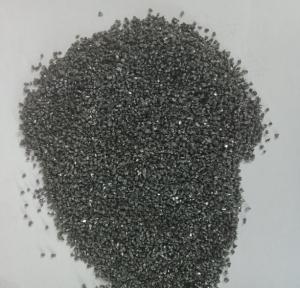Black SIC And Green SIC For cast iron and steel Industry
- Loading Port:
- Shanghai
- Payment Terms:
- TT OR LC
- Min Order Qty:
- 10 m.t.
- Supply Capability:
- 500000 m.t./month
OKorder Service Pledge
OKorder Financial Service
You Might Also Like
Specifications of SiC:
Black SIC And Green SIC lump,grain,grit and micropowder for refractory or abrasive. Size can be based on customer's requirement.
- Description:
Silicon carbide is produced at high temperature in an electric resistance type furnace with quarts sand and petroleum coke as its main raw materials. Its hardness is between fused alumina and synthetic diamond. Mechanical intensity of it is higher than fused alumina. It is sharp and has electrical and heat conductivity in some degree.
- Application:
♦As the abrasive: used for abrasive, such as grinding wheels, whetstone, grinding wheel, sand tiles etc.
♦As the metallurgical deoxidizer and high temperature material.
Four main application areas of SiC: functional ceramics, advanced refractory, abrasives and metallurgical materials.
♦High purity single crystal, used to manufacture semiconductors, manufacture of silicon carbide fibers.
♦Silicon carbide is very hard, with excellent thermal conductivity, as a semiconductor and high temperature
resistant to oxidation.
- Partical Size:
♦Lumps: 0-20mm, 0-50mm.
♦Grains: 0-1mm, 1-3mm, 3-5mm, 5-8mm, 0-10mm, 1-10mm, etc. 7/14, 14/30, 36/70, etc.
-100mesh, -200mesh, -325mesh, etc.
♦Grits: F12-90, F100-240.
♦Micropowder: F320-2000.
*Note: the size can be based on customers requirement.
- Specification
SIC98.5%, SIC98%, SIC97%, SIC95%,SIC90%, SIC88%, SIC85%, SIC80%, SIC75%, SIC70%, SIC65%, SIC55%, SIC50%
*Note: the specification can be based on customers requirement.
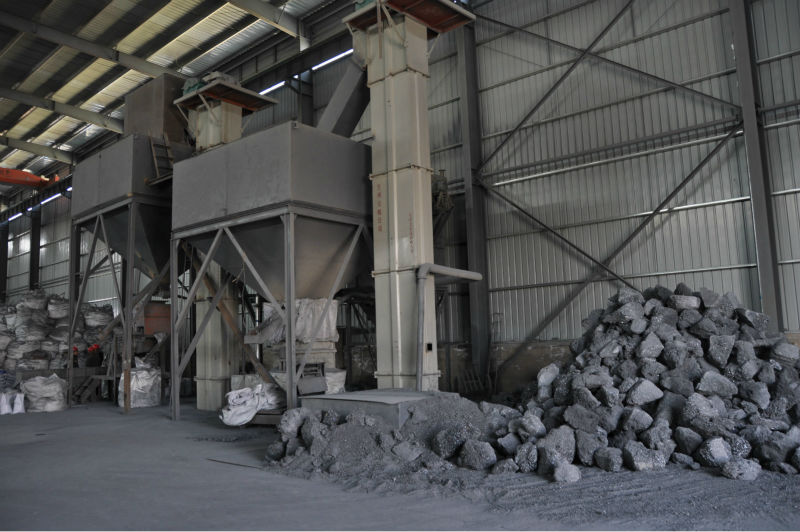
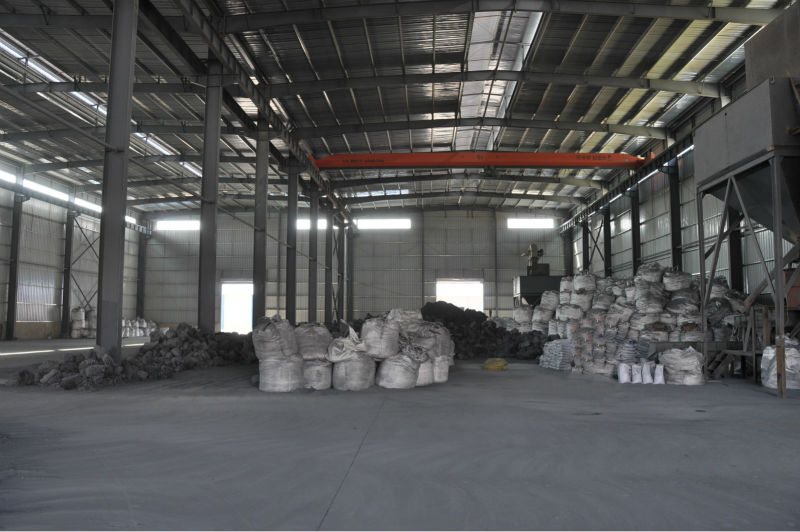
- Q: Are carbon fibers organic polymer materials?
- The fiber spacing is similar to artificial graphite and turbostratic carbon fiber.[5] levels between about 3.39 to 3.42A, the parallel plane between each carbon atom, as well as regular arrangement of graphite, and the layers are connected together by van Edward.Therefore, carbon fiber is an inorganic high polymer fiber with carbon content higher than 90%
- Q: How is carbon used in the production of diamonds?
- The production of diamonds relies heavily on carbon, which is the primary component that constructs the diamond's structure. Deep within the Earth's mantle, where there are extreme levels of heat and pressure, carbon atoms bond together in a distinctive crystal lattice formation, giving birth to diamonds. This natural process, called carbon crystallization, takes place over an extensive period of millions of years. To create synthetic diamonds, scientists recreate these intense conditions in a laboratory. They employ high-pressure, high-temperature (HPHT) machines to subject a tiny piece of carbon, like graphite, to immense pressure and heat. This simulation imitates the natural process that occurs in the Earth's mantle, allowing the carbon atoms to rearrange themselves and transform into diamonds. An alternative method, known as chemical vapor deposition (CVD), involves the controlled use of a hydrocarbon gas, such as methane, in a specific environment. The gas is introduced into a chamber and heated, causing the carbon atoms to separate from the hydrogen atoms. These carbon atoms then settle on a substrate, like a diamond seed, and gradually accumulate layer by layer, eventually forming a diamond. In both methods, carbon acts as the fundamental building block for the diamond's structure. By manipulating the conditions in which carbon atoms are exposed to extreme heat and pressure, scientists and manufacturers are able to control the growth and formation of diamonds. This manipulation allows for the production of synthetic diamonds that possess identical physical and chemical properties to natural diamonds. In conclusion, carbon plays an indispensable role in the production of diamonds, serving as the essential element that facilitates the formation and growth of these valuable gemstones.
- Q: Method for making carbon fiber board
- Method for making carbon fiber sheet:1, first determine the thickness of the plate to be made2 calculate the required number of plies according to the thickness3, and then according to 0 degrees, 45 degrees, 90 degrees, -45 degrees in the order of stacking.4, and then molding it!Now carbon fiber board, in fact, many in the middle are entrained with some glass fiber cloth, of course, there are all carbon, a little more expensive!
- Q: How do forests act as carbon sinks?
- Forests act as carbon sinks by absorbing carbon dioxide from the atmosphere through the process of photosynthesis. Trees and other plants take in carbon dioxide and convert it into oxygen, while storing the carbon in their trunks, branches, and roots. This stored carbon remains in the forest ecosystem, reducing the amount of greenhouse gases in the atmosphere and helping to mitigate climate change.
- Q: What are the consequences of increased carbon emissions on coral reefs?
- The consequences of increased carbon emissions on coral reefs are highly detrimental. Elevated carbon dioxide levels in the atmosphere lead to ocean acidification, which negatively impacts the ability of corals to build their calcium carbonate skeletons. This results in weakened and brittle coral structures, making them more susceptible to damage from storms and other environmental stressors. Additionally, higher temperatures caused by carbon emissions contribute to coral bleaching events, where corals expel the symbiotic algae that provide them with essential nutrients and vibrant colors. These combined effects of ocean acidification and warming ultimately lead to significant coral reef degradation, loss of biodiversity, and the decline of ecosystem services provided by these valuable marine habitats.
- Q: How is carbon used in the production of paints and pigments?
- Carbon is used in the production of paints and pigments primarily as a black pigment. Carbon black, which is derived from the incomplete combustion of hydrocarbons, is mixed with binders to create black paints and pigments. It provides excellent opacity, color retention, and UV resistance, making it a popular choice in various applications, including automotive coatings, printing inks, and architectural paints.
- Q: How does carbon contribute to the color of gemstones?
- Carbon contributes to the color of gemstones through its ability to absorb certain wavelengths of light. When carbon is present in gemstones, it can create various color centers that give the gemstone its distinct hue, such as yellow in diamonds or blue in sapphires.
- Q: What are the impacts of carbon emissions on the stability of permafrost?
- Carbon emissions have significant impacts on the stability of permafrost. As carbon dioxide and other greenhouse gases accumulate in the atmosphere, they trap heat, leading to global warming. This rise in temperatures causes permafrost, which consists of permanently frozen soil and rock, to thaw. The thawing of permafrost releases large amounts of carbon dioxide and methane, intensifying the greenhouse effect and further contributing to climate change. Additionally, as permafrost thaws, it destabilizes the ground, resulting in land subsidence, infrastructure damage, and increased erosion. These impacts can have cascading effects on ecosystems, indigenous communities, and the overall stability of the environment.
- Q: How do human activities contribute to carbon emissions?
- Human activities contribute to carbon emissions in various ways. One major source is the burning of fossil fuels such as coal, oil, and natural gas for transportation, electricity generation, and industrial processes. Deforestation and land-use changes, mainly for agriculture and urbanization, also release significant amounts of carbon dioxide into the atmosphere. Additionally, industrial processes, including cement production and chemical manufacturing, release greenhouse gases. Overall, our reliance on fossil fuels and unsustainable land management practices are the primary drivers of human-induced carbon emissions.
- Q: What is carbon neutral tourism?
- Carbon neutral tourism refers to a form of tourism that aims to minimize or eliminate the carbon footprint generated by travel and related activities. It is an approach that seeks to balance the amount of carbon dioxide released into the atmosphere with an equivalent amount of carbon dioxide removed or offset. To achieve carbon neutrality, tourism operators and destinations take various measures to reduce their greenhouse gas emissions. This can include using renewable energy sources, implementing energy-efficient practices, promoting sustainable transport options, and adopting eco-friendly technologies. Additionally, carbon offsetting is often employed, which involves investing in projects that reduce greenhouse gas emissions elsewhere, such as reforestation or renewable energy initiatives. The concept of carbon neutral tourism recognizes the significant contribution of the travel and tourism industry to global carbon emissions. According to the United Nations World Tourism Organization, tourism accounts for around 8% of global greenhouse gas emissions. By embracing carbon neutrality, the industry acknowledges its responsibility to minimize its environmental impact and contribute to climate change mitigation efforts. One of the key benefits of carbon neutral tourism is the reduction of greenhouse gas emissions, which helps combat climate change. By adopting sustainable practices and offsetting remaining emissions, destinations and operators can play a crucial role in preserving natural resources, protecting biodiversity, and minimizing pollution. Moreover, carbon neutral tourism can also enhance the reputation and competitiveness of businesses and destinations, attracting environmentally conscious travelers who prioritize sustainability. However, it is important to note that achieving carbon neutrality is a complex task that requires commitment and collaboration from all stakeholders involved in the tourism industry. It involves measuring and monitoring emissions, setting reduction targets, implementing sustainable practices, and investing in carbon offset projects. Moreover, transparency and credibility are crucial in ensuring that carbon offset initiatives are verifiable and contribute to real emissions reductions. In conclusion, carbon neutral tourism is a proactive approach to minimize the environmental impact of travel and tourism activities. It involves reducing emissions and offsetting remaining ones to achieve a net-zero carbon footprint. By embracing carbon neutrality, the tourism industry can contribute to global climate change mitigation efforts while simultaneously promoting sustainable practices and attracting environmentally conscious travelers.
Send your message to us
Black SIC And Green SIC For cast iron and steel Industry
- Loading Port:
- Shanghai
- Payment Terms:
- TT OR LC
- Min Order Qty:
- 10 m.t.
- Supply Capability:
- 500000 m.t./month
OKorder Service Pledge
OKorder Financial Service
Similar products
Hot products
Hot Searches
Related keywords
